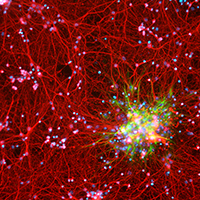Quantitative, structural and molecular changes in neuroglia of aging mammals: A review

Accepted: 27 May 2021
HTML: 11
All claims expressed in this article are solely those of the authors and do not necessarily represent those of their affiliated organizations, or those of the publisher, the editors and the reviewers. Any product that may be evaluated in this article or claim that may be made by its manufacturer is not guaranteed or endorsed by the publisher.
Authors
The neuroglia of the central and peripheral nervous systems undergo numerous changes during normal aging. Astrocytes become hypertrophic and accumulate intermediate filaments. Oligodendrocytes and Schwann cells undergo alterations that are often accompanied by degenerative changes to the myelin sheath. In microglia, proliferation in response to injury, motility of cell processes, ability to migrate to sites of neural injury, and phagocytic and autophagic capabilities are reduced. In sensory ganglia, the number and extent of gaps between perineuronal satellite cells – that leave the surfaces of sensory ganglion neurons directly exposed to basal lamina– increase significantly. The molecular profiles of neuroglia also change in old age, which, in view of the interactions between neurons and neuroglia, have negative consequences for important physiological processes in the nervous system. Since neuroglia actively participate in numerous nervous system processes, it is likely that not only neurons but also neuroglia will prove to be useful targets for interventions to prevent, reverse or slow the behavioral changes and cognitive decline that often accompany senescence.
How to Cite
PAGEPress has chosen to apply the Creative Commons Attribution NonCommercial 4.0 International License (CC BY-NC 4.0) to all manuscripts to be published.
Similar Articles
- E Bonanno, G Tagliafierro, EC Carlà, MR Montinari, P Pagliara, G Mascetti, LG Spagnoli, L Dini, Synchronized onset of nuclear and cell surface modifications in U937 cells during apoptosis , European Journal of Histochemistry: Vol. 46 No. 1 (2002)
- A Spano, L Sciola, G Monaco, S Barni, Relationship between actin microfilaments and plasma membrane changes during apoptosis of neoplastic cell lines in different culture conditions , European Journal of Histochemistry: Vol. 44 No. 3 (2000)
- K Hirai, M Kumakiri, K Ueda, Y Imamura, S Noriki, Y Nishi, H Kato, M Fukuda, Clonal evolution and progression of 20-methylcholanthrene-induced squamous cell carcinoma of mouse epidermis as revealed by DNA instability and other malignancy markers , European Journal of Histochemistry: Vol. 45 No. 4 (2001)
- Karel Smetana, Dana Mikulenková, Josef Karban, Marek Trněný, To the ring-shaped nucleolus seen by microscopy using human lymphocytes of blood donors and chronic lymphocytic leukemia patients , European Journal of Histochemistry: Vol. 68 No. 3 (2024)
- EV Sheval, MA Polzikov, MOJ Olson, OV Zatsepina, A higher concentration of an antigen within the nucleolus may prevent its proper recognition by specific antibodies , European Journal of Histochemistry: Vol. 49 No. 2 (2005)
- Xin Kong, Qi Wang, Jie Li, Ming Li, Fusheng Deng, Chuanying Li, Mammaglobin, GATA-binding protein 3 (GATA3), and epithelial growth factor receptor (EGFR) expression in different breast cancer subtypes and their clinical significance , European Journal of Histochemistry: Vol. 66 No. 2 (2022)
- Carlo Alberto Redi, Liver stem cells - Methods and protocols , European Journal of Histochemistry: Vol. 57 No. 3 (2013)
- Monica Colitti, Federico Boschi, Tommaso Montanari, Dynamic of lipid droplets and gene expression in response to β-aminoisobutyric acid treatment on 3T3-L1 cells , European Journal of Histochemistry: Vol. 62 No. 4 (2018)
- K Smetana, K Kuželová, M Zápotocky, J Starková, Z Hrkal, J Trka, Mean diameter of nucleolar bodies in cultured human leukemic myeloblasts is mainly related to the S and G2 phase of the cell cycle , European Journal of Histochemistry: Vol. 51 No. 4 (2007)
- F Corallini, A Gonelli, F D’Aurizio, MG di Iasio, M Vaccarezza, Mesenchymal stem cells-derived vascular smooth muscle cells release abundant levels of osteoprotegerin , European Journal of Histochemistry: Vol. 53 No. 1 (2009)
<< < 55 56 57 58 59 60 61 62 63 64 > >>
You may also start an advanced similarity search for this article.

 https://doi.org/10.4081/ejh.2021.3249
https://doi.org/10.4081/ejh.2021.3249










